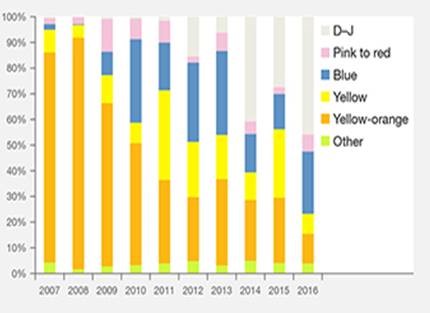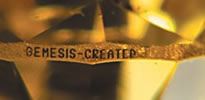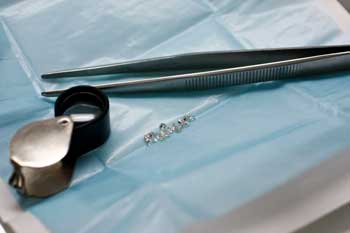FRAUD UPDATE
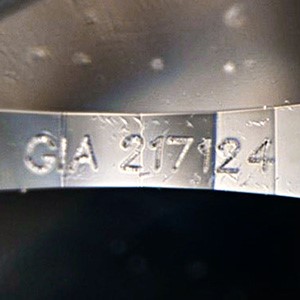 – lack of disclosure, false inscriptions & doctored docs
– lack of disclosure, false inscriptions & doctored docs
An example:
A diamond was submitted to GIA for an updated grading report. The stone's girdle was inscribed with a GIA report number.
This should have been an easy update. But it turned out to be fraud.
Here's what GIA found:
The qualities of the diamond being tested did not match those on the original report.
This sample being tested was:
- two color grades lower
- two clarity grades lower
- inscribed with a font not used by GIA
Additional testing showed this stone to be:
- lab-grown diamond, not a mined diamond as the report described.
- This stone was not previously graded by GIA, because all diamonds identified as synthetic leave GIA's lab with the inscription "Laboratory Grown."
This incident is worrisome because it exemplifies the increasingly elaborate schemes for passing lab-made stones without disclosure.
Value of mined diamond v. lab-made
Lab-grown diamonds are in all respects diamond. The issue is how they were created.
Although diamonds grown in a lab have the same composition and properties as mined diamonds, lab-made diamonds are priced about 30% below mined diamonds of similar size and quality. And growers are setting their targets to get the price down to 50% that of mined diamonds!
Since the lab-made sample above was not only lab-made but of lesser quality than the diamond it purported to be, the value difference would be much greater. If this diamond were sold—and priced—based on the description in the GIA report, the buyer would have been seriously cheated due to the pricing difference.
Diamond-growing technology
Labs have made industrial-grade diamonds since the 1940s. Valued for their hardness, these diamonds were used in cutting, grinding and polishing procedures. Qualities like color and clarity were not relevant.
About 15 years ago labs began to start manufacturing gem-quality diamond. Early efforts could produce only small, off-color stones, which were often enhanced to deeper colors and marketed as fancies. Improvements in growth processes now make it easier to grow colorless diamond, and to maintain growth over a long enough period to produce larger crystals.
The graph at right, showing the colors of lab-made diamonds submitted to GIA for grading over the past decade, gives a sense of the progress toward producing colorless diamond.
Now both color and size barriers have been overcome, and the number of diamond-growing labs around the world is increasing. GIA foresees ever-growing production of lab-made stones, especially in melee and in stones over 4 carats. The increasing number of lab-made stones, and the improved quality, increases the risk of fraud.
Recognizing lab-made stones
Gems from the best diamond growers are almost indistinguishable from mined diamond.
Reputable manufacturers are proud of their work and inscribe their name on their gems. They also properly advertise them in a way that does not mislead the buyer.
However, not all manufacturers want to be known. Distinguishing synthesized diamond requires very expensive equipment, far beyond the reach of an independent jeweler or appraiser, or even of most gem grading labs.
GIA is one of the few diamond-grading labs with the necessary equipment and the means to continually update its expertise in this rapidly changing field. The GIA lab deliberately studies stones from known manufacturers, so graders can familiarize themselves with features that distinguish lab-grown gems.
But in the marketplace, a lab-made stone could easily be passed off—and priced--as mined.
How common is this fraud?
Short answer: We don't know. This subterfuge could occur anywhere along the purchasing chain: wholesale buyers, jewelry manufacturers, retail jewelers, consumers.
Diamond buyers purchase stones in parcels containing several diamonds to several hundred diamonds. Over the past few years there have been a number of reports of lab-made diamonds mixed in parcels of natural mined diamonds. Sometimes the majority of diamonds in a parcel are found to be synthetic.
It's not common practice for wholesale buyers to have each diamond in a parcel individually lab-appraised, as the cost would be prohibitive. This is especially true for melee, the tiny diamonds used to offset a center stone.
Melee diamonds can be as small as 0.001 ct (1/1000 of a carat). They are produced in large quantities in factories, and sold in parcels of 100 carats or more (that could be tens of thousands of pieces) to jewelry manufacturers who set them in jewelry.
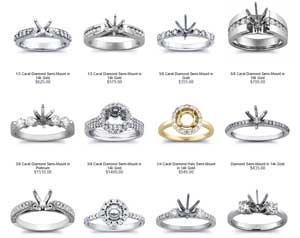 In fact, retail jewelers rely on manufacturers to supply them with "semi-mounts"—rings of various styles that are already set with melee, so only the larger stones need be added. The customer can choose her setting from the jeweler's (or website's) display of semi-mounts, then choose a center stone.
In fact, retail jewelers rely on manufacturers to supply them with "semi-mounts"—rings of various styles that are already set with melee, so only the larger stones need be added. The customer can choose her setting from the jeweler's (or website's) display of semi-mounts, then choose a center stone.
The picture shows a selection of semi-mounts from a site for consumers; retailers have access to far more style choices, some pieces containing dozens of melee diamonds.
It is unlikely today that manufacturers test all the melee in semi-mounts they send. As technology improves, we hope this will change.
Similarly, jewelry retailers do not have the means to test the diamonds they sell to determine whether they are natural or lab-made. They take the word of their supplier, or they may just assume the diamonds are natural. This situation is a court case waiting to happen. No doubt a retailer who neglects full disclosure will ultimately be found liable for treble damages.
On a jewelry appraisal, melee will be simply described as diamond. A color range and clarity range will cover all melee in the ring, and the carat weight will be given as a total of all the tiny stones.
For large diamonds, parcels salted with synthetics would mean a serious financial loss for the buyer. Even if a manufacturer or jeweler discovers a gem is lab-made, he may decide to use it without disclosure, to avoid that loss.
Once in the jewelry, the lab-made stone may not be properly identified unless the jewelry is damaged. And perhaps not even then, because few labs are equipped to identify lab-made stones, and currently few insurers require verifying a stone's quality before settling a claim. But this, too, will change—out of necessity—and that will mean further tightening of the jewelry insurance market.
GIA inscriptions and reports
Forging a GIA report number adds another very serious level of fraud. It trades on GIA's reputation as the most respected diamond grading lab. "GIA" on a stone or lab report puts everyone at ease; supplier, manufacturer, retailer, consumer, insurer all may give the stone a pass.
Information on GIA lab reports since the year 2000 is available from GIA's website, allowing a consumer or insurer to check a report number. But if a valid GIA number is fraudulently inscribed on an inferior stone, a non-gemologist might overlook quality discrepancies like those described in this article.
With the proper equipment, inscribing a stone is not that difficult. Removing an inscription is even easier, as it can easily be polished off. Without the inscription identifying a stone as lab-made or giving the name of the manufacturer, a lab-grown stone can easily be sold as a mined gem.
Producing counterfeit GIA lab reports is an ongoing problem. One scam involved producing bogus GIA certs to support clarity-enhanced gems. NOTE that GIA does not grade clarity-enhanced stones. If you see a GIA report on a clarity-enhanced diamond, you know the report is fake.
And just last year the industry was shocked to see blatant advertisements for fraud. A Chinese online portal offered "Lab Grown Diamonds with GIA Natural Certificate[s]." Another site, describing itself as "India's top online market," offered a similar product. Both sites were removed after negative notoriety, but who knows if more have cropped up?
We assume the marketers are buying GIA reports on mined stones (available from online auction sites and through other channels), then having lab-made stones cut to match the reports. There is also trafficking in "empty" GIA reports—forms without stone information filled in—so any stone of any quality can appear to be "certified" by GIA. A good question is, what is GIA doing to counter this?
A closing note: Disclosure
Ultimately, it is the seller's responsibility to know his merchandise and to tell a purchaser if a diamond is lab-made. However:
In a survey reported in one jewelry trade magazine a few years ago, 97.4% of the responding jewelers said they disclosed lab-made gems verbally, but only 50.4% disclosed on the sales receipt.
Caveat insurer! You'll never hear those verbal disclosures. Be sure to get the details in print on an appraisal from a disinterested, credentialed gem and jewelry appraiser: a GG, FGA+, or equivalent, who has additional training in appraising for insurance. One course offering such training is the Certified Insurance Appraiser™ course.
FOR AGENTS & UNDERWRITERS
Lab-made diamonds are being sold without disclosure. For now, the insurer's best protection against fraud is to get complete documents: the sales receipt and proof of purchase, a detailed appraisal from a trained gemologist appraiser, and multiple photos of the item. With today's smart phones, clear close-ups of jewelry are easy to take.
For all quality jewelry, request a JISO 78/79 appraisal that gives a detailed description of the jewelry. This appraisal is prepared by a trained gemologist (GG, FGA+, or equivalent), who has additional training in appraising for insurance. One course offering such training is the Certified Insurance Appraiser™ course.
An appraisal should state whether the gem is mined (sometimes called natural) or lab-made.
Be alert to terms used for lab-made diamonds, such as lab-grown, man-made, created, synthesized, cultured. Lab-made diamonds are valued lower than mined diamonds.
HPHT (high pressure high temperature) and CVD (chemical vapor deposition), two methods of creating gems in a lab, are terms that may appear on the appraisal or other docs.
HPHT is also used as a treatment on lab-grown and on mined diamonds. Note that these terms mean the stone has a lower valuation than an untreated mined gem of similar quality.
Despite the scam involving fraudulent GIA certificates, a diamond report from a reliable lab is still good practice. We recommend the following highly respected labs and suggest that you use these links to verify reports you receive.
GIA Report Check
AGS Report Verification
GCAL Certificate Search
If you have any reason to suspect a diamond report is bogus, it may be worthwhile to consult the lab directly.
GIA 800.421-7250 ext 7590
AGS 866.805-6500
GCAL 212-869-8985
FOR ADJUSTERS
With diamonds, the price difference between natural and synthetic is far greater than with most other stones. Mistaking a synthetic diamond for a natural could mean an overpayment of tens of thousands of dollars.
The sales receipt is important. If there is a huge difference between the purchase price and the appraisal valuation, it's a good indication that something is amiss—the stone's qualities are exaggerated, or the gem has color or clarity treatments, or the gem was made in a lab. All these conditions lower the value of a gem.
The diamond industry is struggling to develop dependable and low-cost solutions for detecting synthetics. For larger diamonds that are damaged, it is practical to send them to a large lab such as GIA, which has the latest equipment for identifying lab-grown gems.
Read carefully all documents on file. Do not assume that a gem is natural/mined unless that is specifically stated on the appraisal. It may be time to have all jewelry claims adjusted by a senior adjuster with jewelry experience.
Comb the documents for words meaning synthetic, such as created, grown, lab-made, man-made, lab-grown, and cultured diamond.
A brand name on the stone's girdle or in appraisal documents may indicate a lab-made stone. You'll need a microscope or jeweler's loupe to be able to read an inscription.
If an appraisal contains brand names or terms unfamiliar to you, checking with your staff jewelry expert could save settlement costs.
Always have the damaged jewelry examined in a gem lab by a trained gemologist (GG, FGA+, or equivalent), preferably one who has additional training in appraising for insurance. One course offering such training is the Certified Insurance Appraiser™ course.
©2000-2025, JCRS Inland Marine Solutions, Inc. All Rights Reserved. www.jcrs.com

